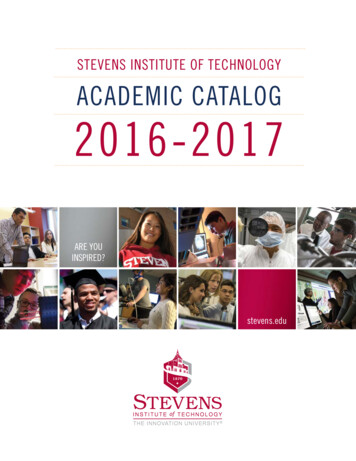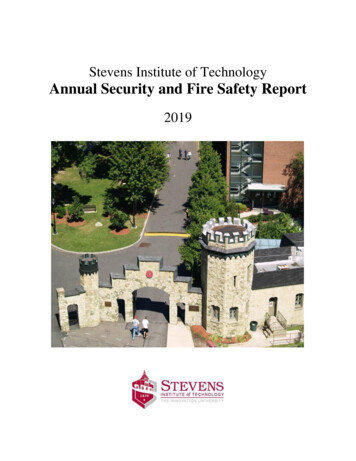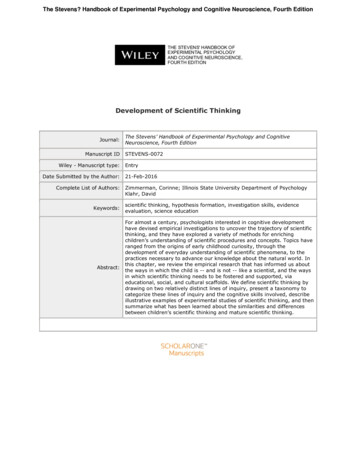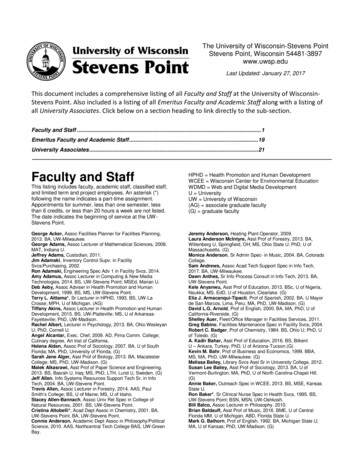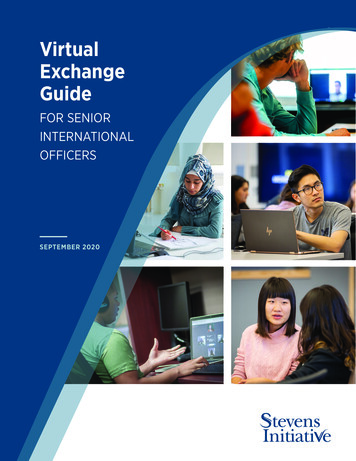
Transcription
VirtualExchangeGuideFOR SENIORINTERNATIONALOFFICERSSEPTEMBER 2020
AcknowledgementsThe Stevens Initiative thanks the following individuals for their encouragement to create this document and fortheir many substantive contributions and helpful edits: GianMario Besana, Associate Provost, Global Engagementand Online Learning, DePaul University; Sally Mudiamu, Director of International Partnerships, COIL Administrator,Portland State University; and Lorette Pellettiere Calix, Faculty and Virtual Exchange practitioner, SUNY EmpireState College. The Initiative is also grateful to the following organizations and their teams for their valuable collaboration on this toolkit: Association for International Education Administrators (AIEA): Darla Deardorff and the Forumon Education Abroad: Melissa Torres, Amelia Dietrich, Elizabeth Frohlich. Mohamed Abdel-Kader, the Initiative’sExecutive Director, managed the production of this guide with critical support from Assistant Director HenryShepherd, Program Associate Haili Lewis, Managing Director Christine Shiau, and Program Manager Andie Shafer.The Stevens Initiative is sponsored by the U.S. Department of State, with funding provided by the U.S. Government,and is administered by the Aspen Institute. It is also supported by the Bezos Family Foundation and the governmentsof Morocco and the United Arab Emirates.
Table of ContentsGoal. 1Defining Virtual Exchange. 1Why Virtual Exchange?. 1Starting a Successful Virtual Exchange. 21.Institutional Scan. 22. Establishing Institutional Buy-In. 33. Choosing the Best Model for Your Campus. 44. Designing Your Own Program. 55. Motivating and Supporting Faculty Participation. 56. Finding Synergy Between Campus Units. 77.Accounting for the Cost of Virtual Exchange. 88. Sustaining and Growing Virtual Exchange. 89. Equity. 910. Resources. 9
The Stevens Initiative is an international effort to build global competence and career readiness skills for young people in the United States and the Middle East and North Africa by growing and enhancing the field of virtual exchange.Created in 2015 as a lasting tribute to Ambassador J. Christopher Stevens, the Initiative is committed to helping toexpand the virtual exchange field through three pillars of work: investing in promising programs, sharing knowledge and resources, and advocating for virtual exchange adoption. The Stevens Initiative has awarded 60 grantsand, by summer 2022, will expand its reach to over 43,000 young people in 16 MENA countries and the PalestinianTerritories, and in 45 U.S. states, Puerto Rico, three tribal communities, the U.S. Virgin Islands, and Washington, D.C.Learn more: https://www.stevensinitiative.org/The Aspen Institute is a global nonprofit organization committed to realizing a free, just, and equitable society.Founded in 1949, the Institute drives change through dialogue, leadership, and action to help solve the most important challenges facing the United States and the world. Headquartered in Washington, DC, the Institute has a campusin Aspen, Colorado, and an international network of partners. Learn more: https://www.aspeninstitute.org/
GoalTo guide Senior International Officers (SIOs) at postsecondary institutions in establishing virtual exchange as a criticalpart of inclusive internationalization.Defining Virtual ExchangeVirtual exchange uses technology to connect people for education and exchange. Virtual exchange programs typically serve young people. Many virtual exchange programs are international, connecting participants in differentcountries to help them gain global competencies, among other knowledge, skills, and abilities. Many practitionersbelieve that facilitation by prepared, responsible adults — often but not always educators — is an important component of successful virtual exchange.Why Virtual Exchange?Young people need the right mindset and skills to navigate the world’s challenges, but they often lack opportunities for global learning, especially at a time when student mobility is limited and finances are constrained. Virtualexchange can help young people develop communication and collaboration skills and a more globally-informedperspective. Virtual exchange can broaden access to international learning for every student, regardless of their circumstances, background, or ability. Virtual exchange is not just a short-term solution to the disruption campuses facetoday but is also part of a comprehensive plan to advance internationalization at home for each institution and eachstudent.Virtual Exchange Guide for SIOs 1
Steps to Starting a Successful Virtual Exchange1. Institutional ScanScan the landscape for virtual exchange at your institution.a) Internationalization Goals: Determine your campus internationalization goals and map outhow virtual exchange can contribute to achieving them, such as by creating conditions fora wider group of students to experience global learning, gain global perspective, or take a course that has aglobal learning component.It is important that you gain alignment amongst your leadership on how virtual exchange is a part of yourinternationalization strategy or plan. Misalignment between leadership could cripple these efforts. Clarify therelationship between virtual exchange and traditional mobility/study abroad – this should not be seen as a“zero sum.” Virtual exchange and mobility as well as other interventions to internationalize the campus cancomplement one another and provide a more rich and seamless experience for students.If your institution hasn’t established internationalization as a goal, consider advocating for the adoption of acomprehensive internationalization framework and the formation of an internationalization council if therearen’t clear commitments and systems in place. See the internationalization framework, with six key targets, developed by the American Council on Education.b) Assess the Disruption: Gain an understanding of how the pandemic or other event has impacted your international activities (students not on campus, visiting fellows not present, inbound and outbound study abroadopportunities postponed, etc.) and evaluate whether a virtual exchange can be of value where disruption hasoccurred.c) Identify On-Campus Champions: There are likely people on campus – particularly faculty, but also potentiallygraduate instructors, instructional technology, research project leaders, international engagement staff, etc. –who already conduct virtual exchange or something like it (telecollaboration and globally networked learningare sometimes used to refer to similar practices). They can help demonstrate and mentor others who want toget involved. Build on those successes. Solicit their feedback and expertise. They may have already connected with the different assets on your campus and understand some of the opportunities and challenges.d) Asset Mapping: What institutional assets are available to support the development and scaling of virtualexchange programs? Consider how supporting virtual exchange might meet some of the needs and bemutually beneficial to colleagues in these areas, as well.i) Curricular Approval: Who approves changes in course curricula and delivery (e.g. the provost’s office or afaculty governance committee)? What approvals, if any, are needed to hold a virtual exchange programin a course or as an extracurricular experience? Consider, too, that virtual exchange can often be addedto an existing course without requiring curriculum committee approval.ii) International Partnerships: These can be a valuable resource to help connect with partner institutionsand the faculty there. Having a committed virtual exchange partner is one of the most important aspectsof conducting a successful virtual exchange. See the partnerships section below for more information onpartnerships.2 Virtual Exchange Guide for SIOs
iii) Curricular Design and Online Learning Unit: Your institution may already have invested in administrativeunits to deliver online learning and help with new learning models, particularly in response to the needto build capacity for online instruction during the pandemic. Don’t assume that adding Zoom and aninternational partner are all that is necessary for a successful virtual exchange; a curricular design teammay be helpful with the virtual exchange integration. Later in this guide, resources are shared for effective course and program implementation.iv) Global Learning and Education Abroad Offices: These offices can be invaluable allies in providing globallearning expertise, in reaching students, faculty, and staff, and in potentially being a bridge to new virtualexchange implementation partners.v) Office of Diversity, Equity, and Inclusion (DEI): Your DEI office can be a helpful resource in ensuringyour virtual exchange program curriculum incorporates principles of equity and cultural sensitivity andmaintains a balance in power dynamics. Your DEI team can also guide you to make sure your program isaccessible and inviting to all students.vi) Information Technology: Consider who oversees the campus technology infrastructure – bandwidth,hardware (such as webcams, screens, and computers), smart classrooms, and other technology platforms (such as Zoom, Skype, Google suite, etc.). They can also be a great asset to address securityconcerns.e) Gaps in Resources: Understand what resource or asset gaps might hinder virtual exchange implementationat your institution. Perhaps your institution does not have a curricular design unit or a faculty training center.Consider solutions or workarounds that you or your colleagues can put in place to support practitioners.Don’t forget that your potential partner institutions may have capabilities to complement yours.f)Incentives and Barriers: Consider which units on campus might be concerned about a possible negativeimpact from increased virtual exchange. How can you reassure your colleagues that virtual exchange is not athreat but rather a complement to, or even a way to raise interest in, other forms of international exchange?Consider structuring a virtual exchange in a manner that is additive to complement existing internationalization efforts.2. Establishing Institutional Buy-InVirtual exchange is ultimately about a partnership between two or more classrooms/institutions, but also about units on campus working in concert to make sure the virtualexchange program provides a seamless and successful experience for students. Nurturing the buy-inof necessary campus stakeholders is an important aspect of any virtual exchange. Which of the unitsin the previous section will be critical partners and allies in helping a virtual exchange program besuccessful faculty campus?a) Mobilize Faculty Champions: You’ve already identified faculty champions of virtual exchange. Reach out tothem and invite them to play a significant role in presenting virtual exchange to their colleagues and in mentoring new practitioners.b) Start Small and Build: Consider focusing early efforts on one division or department that is well-suited topiloting virtual exchange, such as faculty who have conducted some virtual exchange or who are enthusiasticVirtual Exchange Guide for SIOs 3
to get involved; fields that involve subjects with compelling international themes and linkages. Then,expand as you are able to share data and faculty and student testimonies that demonstrate the value of theexperience.c) Research: Share research demonstrating the positive results of virtual exchange, particularly how virtualexchange helps prepare students for jobs that require global competence. The Stevens Initiative shared anannotated bibliography of some recent publications. Scholars and practitioners continue to publish articlesand other resources that illustrate the case for virtual exchange.d) Access: Students who wish to study abroad and gain global competencies often encounter barriers (financial, curricular, global events, etc.). Note the impact of virtual exchange on student success and how virtualexchange can help students acquire global competencies.e) Articulate the Commitment: Develop an institutional statement in support of virtual exchange. This wouldmake it clear to people across campus that virtual exchange is a priority within your institution’s internationalization strategy.f)Provide Resources: Micro-grants or funding for trainings can be a powerful way to reward and incentivizefaculty members and academic units to integrate virtual exchanges into their courses and programs and toshow ongoing support for faculty while they are teaching.g) Coordination: Name someone to promote and coordinate virtual exchange efforts, even if it is a small partof their job. They can lead a “community of practice,” where support and mentorship can be an offering toguide faculty.3. Choosing the Best Model for Your CampusOnce you’ve decided you want virtual exchange on your campus, you can design yourown program with a partner, have a third party help provide the service for your team,or a combination of both.a) Designing your own virtual exchange program allows you to customize the virtual exchange experience toyour liking but may require more effort.b) A third-party provider can give your students the opportunity to connect in a pre-existing program that mayfit with many, but not all, courses. The third party will generally have their own platform, coordinate curriculum and sessions, and be responsible for finding partners. This outsourced model is often an easier pathwayto implementation but there may be fees associated with this approach. In some cases, the Stevens Initiativemay be able to support your participation in a limited number of programs.For more information, fill out our Join a Program form.4 Virtual Exchange Guide for SIOs
4. Designing Your Own ProgramIf you choose to design your virtualexchange program(s) with partners: Yourvirtual exchange partner(s) are a criticalpiece of your program.a) Finding a Partner: Partners can be found through yourinstitutional partnerships, through faculty or staff connections, or through associations and professional networks.Partners could be individual, departmental, or institutional. A partner should have a similar vision for the virtualexchange program.b) Designing: When designing a virtual exchange program,your respective teams will work together on issues suchas co-designing the course interactions, selecting a technology platform(s), and scheduling sessions based onmutually agreed upon terms. See the Forum on EducationAbroad Guide to Online Learning and COIL CourseDevelopment Manual for more details.c) Mutuality: Work together with your partner institution soyour program serves both sets of students in a balancedmanner. Collaboration should benefit both sides, thoughthe benefits can be different (for example, one classroommay be seeking Spanish language practice, while anotherwants to engage in project-based learning).5. Motivating and SupportingFaculty ParticipationAs the SIO, there are numerous ways foryou to keep faculty motivated and engagedin facilitating virtual exchange programs.a) Share Information: Present information on virtual exchangeat faculty meetings or to the faculty interest group oninternationalization (if such a group exists). Create an informational flyer to highlight for interested faculty how theycould use virtual exchange to expand their internationalwork or create a global dimension to their efforts.b) Recruit Creatively: Recruit among faculty who have ledshort-term study abroad programs (who might haveconnections to potential partners) and have an interest inconducting virtual exchanges.Case 1The William DavidsonInstitute at the Universityof Michigan has connectedits business school with theAmerican University of Beirut,American University of Cairo,and an NGO in Libya to conduct a virtual exchange-enhanced course for undergraduates titled “Business andCulture.”To learn more about the program, click here.Case 2Soliya is an NGO offering animmersive, dialogue-basedvirtual exchange. TheirConnect program offers virtual exchange programmingthat integrates with existing coursework in coordination with faculty. Studentsengage in synchronous virtualexchange sessions once a weekoutside of course time for twohours to discuss internationalrelations and then continue thediscussion in their respectiveclassrooms.To learn more about Soliya’sConnect program, click hereand watch this video.Virtual Exchange Guide for SIOs 5
c) Highlight Successes: Share the successes of the championson your campus to attract more faculty to the endeavorand build momentum. This can be done by recognizing allstar practitioners by giving them awards; naming them asvirtual exchange ambassadors; inviting them to hold brownbag lunch presentations; or showcasing them in a newsletter, website, social media feature, or publication.d) Provide Training: Those seeking to design and conductvirtual exchange may be looking for professional development opportunities. Offer to provide these training opportunities. Cap training enrollment at reasonable numbers toensure each faculty member gets adequate attention andsupport. Try to incorporate international partner facultyin the trainings to simultaneously build their knowledgeand ensure they work in partnership with your institution’sfaculty. Trainings can include sections on program/coursedesign, coordination, selecting and managing the technology, facilitating the virtual exchange, and evaluating theimpact of the program on students. Additionally, manyconferences and other institutions offer trainings available to faculty.Case 3Many institutions offer stipends or micro-grants asincentives for faculty membersto develop virtual exchangecourses. Stipends often rangebetween 1,500 to 3,500 andcan cover travel expenses orstart-up costs for both collaborating faculty to build thepartnership.e) Support with Additional Resources: Provide resources for training and implementation, such as stipends orsmall grants for course development, for faculty members who commit to run the virtual exchange multipletimes.f)Provide Travel Opportunities: This could include a stipend for travel to meet in person with the faculty member’s international partner and their partner’s students, either before, during, or after the virtual exchange (ifconditions allow travel).g) Evaluate the Impact: Work with faculty and staff to incorporate evaluation into all virtual exchange programsand courses. Draw on existing tools and methods such as surveys and scales developed by the StevensInitiative or others to demonstrate impact. Get student feedback. Make adjustments, and refine the program.This can be done by the faculty member or administrative team facilitating the virtual exchange. It can alsobe done in conjunction with another administrative unit on campus responsible for evaluation. The StevensInitiative has made its Evaluating Virtual Exchange toolkit and appendix of survey questions availableto all practitioners in addition to the Protocols for Collecting Qualitative Data About Virtual ExchangePrograms. Feel free to modify the survey questions to suit your needs.h) Support Faculty Professional Development: Support opportunities for faculty to attend and present at conferences to both learn from others and gain recognition by sharing their work.i)Provide Course Load Relief: Reduce the course load or enrollment expectations for faculty who are participating in training or conducting virtual exchange.j)Refine Hiring and Promotion Criteria: Add virtual exchange to the criteria for evaluating or hiring faculty,including considerations for tenure and continuing appointment, so their effort and achievement are recognized. Acknowledge that even if the collaboration is not a resounding success, the faculty effort and contribution to internationalization goals merit recognition.6 Virtual Exchange Guide for SIOs
6. Finding Synergy Between Campus UnitsAs the SIO, you can help make important connections to other campus units.a) Enrollment Management: Virtual exchangecan be a powerful way for internationalstudents to learn about your institution. This can serve asan introduction point for your institution to recruit international students for subsequent academic program enrollment. How can virtual exchange be part of your strategy toengage future applicants and to keep U.S. and internationalstudents engaged?b) Study Abroad: Virtual exchange and study abroad aredifferent educational interventions – virtual exchange isnot “study abroad light” – it is a different experience. Withthat said, a virtual exchange program and study abroadprogram can complement one another to build a strongerpathway to study abroad and continue the engagementafter the experience abroad. Given the disruption causedby the pandemic, many campuses are quickly moving tovirtual exchange programs to keep global learning goingfor students who may not be able to experience a studyabroad at this time.c) Communications and Development: You should communicate about your virtual exchange to both internal andexternal audiences. The development team may be able tocultivate philanthropic support from alumni and donors toadvance your endeavor. If you include virtual exchange andcampus internationalization as a priority in your next capital campaign, your development team should be involved.Case 4Data from the past severalyears of virtual exchangeat East Carolina Universitysuggest students – and particularly students of color – whoparticipate in virtual exchangeare more likely to subsequentlystudy abroad later in theircollege careers. Jami Leibowitz,ECU’s Associate Director GlobalAffairs and Director GlobalAcademic Initiatives, points tothis preliminary informationto bolster the case for virtualexchange as a complementto other internationalizationefforts with leaders acrosscampus.Virtual Exchange Guide for SIOs 7
7. Accounting for the Cost of Virtual ExchangeWhile virtual exchange can be a cost-effective tool to internationalize your institution, itstill requires an investment based on your aspirations and program design.a) Cost Per Participant: Like other education and exchange methods, virtual exchange has a cost, but the costper student can be relatively lower than the cost for many traditional, in-person programs. Programs operating at a small scale may be able to get by with very little spending at the start. For example, faculty may bewilling to invest their time in designing the program, their salaries may already be covered, and the programmight use existing technology platforms and devices. As virtual exchange programs seek to grow or sustainover time, a larger portion of the cost – for faculty stipends, administrative time, training, technology, evaluation, other expenses, and possibly even covering some of these costs at partnering campuses – may needto be explicitly covered to carry out the program. Larger and more efficient programs may begin to benefitfrom economies of scale. The full cost of a virtual exchange program is typically a few hundred to severalhundred dollars per student, depending on program specifics.b) Creative Funding Sources: The pandemic underscores the need to recognize, and find ways to cover thecost of, virtual exchange programs. It is increasingly important to find ways to fund these programs withoutrelying on discretionary funds or revenue from student mobility, both of which are often in short supply.Those in the virtual exchange field continue to discuss how to establish sustainable models for funding virtual exchange programs so they can self-support through tuition, fees, or other arrangements, such as directphilanthropic support.8. Sustaining and Growing Virtual ExchangeIf you’re just starting your virtual exchange program, you may not be thinking aboutsustaining a program and growing it over time, but it’s never too early to begin thinkingabout the future. There are various approaches to do so.a) Make virtual exchange a permanent part of your campus internationalization efforts.b) Identify financial support structures that can help a program continue over time, such as revenue from tuitionand fees, or philanthropic endowments to help institutionalize your courses or program. Consider includingvirtual exchange as a priority in your next capital campaign.c) Stay in contact with faculty who conduct virtual exchange. Hold quarterly lunches (online or in-person).Encourage and incentivize faculty members to repeat the exchange or incorporate virtual exchange intoanother course.d) Empower faculty to be champions and advocates, especially as they seek to publish and present promisingdata and observations from their virtual exchange experiences.e) Incorporate virtual exchange into a system of digital badging or micro-credentialing to document studentwork and help them demonstrate the value of their virtual exchange experience as an asset for the 21st century job market.8 Virtual Exchange Guide for SIOs
9. EquityReal-world inequities can often manifest themselves in a virtual exchange program.Successful programs will be intentional in how they navigate issues that may contributeto inequities and imbalances between participants.a) Involve faculty from all participating countries and institutions from the beginning of the program design andfacilitator training process. Investing in genuine collaboration is not only more equitable, it also contributesto deeper, more sustainable partnerships.b) Provide equal incentives to faculty from all participating institutions with regard to funding or otherresources for setting up or conducting a virtual exchange.c) Translate all communications and materials when a virtual exchange connects faculty and students whospeak different languages.d) Recognize the involved individuals and institutions in all participating countries in publications or presentations about the virtual exchange.e) Let faculty know what to expect about the additional work involved in setting up and conducting a virtualexchange. Explain that the initial investment can prove to be worthwhile as they gain technology and collaboration skills and have rewarding teaching experiences.10. ResourcesThe Stevens Initiative develops and curates resources to support the implementation ofvirtual exchange globally.a) Stevens Initiative Resource Pageb) SUNY Collaborative Online International Learning (COIL) Center and course design guidec) Stevens Initiative Ways to Engaged) The Forum on Education Abroad’s Online Global Learning Experiences Guidee) Stevens Initiative Evaluating Virtual Exchange toolkit, Appendix of survey questions and Protocols forCollecting Qualitative Data About Virtual Exchange Programsf)Stevens Initiative Annotated Bibliography on Virtual Exchange Researchg) American Council on Education’s Comprehensive Internationalization Frameworkh) Webinar on Virtual Exchange and Campus InternationalizationVirtual Exchange Guide for SIOs 9
Virtual Exchange Guide for Senior International OfficersThe Aspen InstituteVirtual Exchange Guide for Senior International Officers is licensed2300 N St. NW, Suite 700, Washington, DC 20037under Creative Commons Attribution-Non-CommercialShareAlike 4.0International LicenseCopyright 2020 by The Aspen InstituteENGAGE WITH inst.org@StevensInit/StevensInitiativePublished in the United States of America in 2020by The Aspen Institute. All rights reserved
The Stevens Initiative is an international effort to build global competence and career readiness skills for young peo- ple in the United States and the Middle East and North Africa by growing and enhancing the field of virtual exchange. Created in 2015 as a lasting tribute to Ambassador J. Christopher Stevens, the Initiative is committed to helping to

